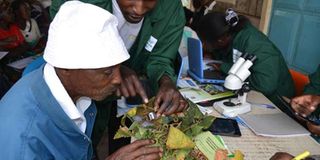How plant clinics can help spread extension services

John Mutisya, a plant doctor, uses a magnifying lens to show Patrick Kitili what his crop is suffering from during a plant clinic in Machakos. PHOTO | ISAIAH ESIPISU |
What you need to know:
- Currently, Kenya only has 200 plant doctors with each serving up to 1,000 farmers.
- The clinics are helping farmers to detect pests and diseases early and this reduces losses.
With the rapidly changing climatic conditions, there is evidence that farmers are facing many challenges including new diseases and pests.
Some of the pests and diseases are completely devastating, thus, it calls for new approach in dealing with the emerging challenges.
The agriculture function was devolved to counties and therefore the devolved units must play a key role in helping farmers overcome these challenges if we are to be food secure.
One way to go about it is by embracing ‘‘plant clinics’’.
These services are already being offered in some parts of the country following successful pilots by Centre for Agricultural Bioscience International (CABI), through their programme Plantwise.
DIAGNOSE DISEASES
Just like in your usual human clinic, farmers take their infected, infested and affected crops to plant clinics in designated areas where experts (plant doctors) diagnose pests and diseases and advise them accordingly.
The plant clinics are currently run by the Ministry of Agriculture, Livestock and Fisheries, with technical support from the Kenya Plant Health Inspectorate Service, the Kenya Agricultural and Livestock Research Organisation, University of Nairobi and the Pest Control Products Board.
Other partners include Agrochemicals Association of Kenya and Seed Trade Association of Kenya.
It is time for county governments to take up the concept and provide these services even at ward levels to save farmers losses.
The plant clinics will help address the current problems the counties are facing in provision of extension services, where a single officer is expected to serve up to 1,000 farmers.
However, the county governments should know that in the wake of climate changes, there is need to re-train the plant doctors so that they are familiar with emerging trends in crop disease and pest control.
The beauty of this is that with support from universities and research organisations, the trainers can disseminate their knowledge to thousands of experts all over the country.
EARLY DETECTION
Currently, there are less than 200 fully trained plant doctors under the current scheme. That 11,600 plant health queries have been recorded from the 13 counties in which the programme has been implemented in the past three years is an indication that farmers are interested in understanding the health of their crops.
In developed societies, plant clinics have been used for early pest and disease detection and management.
As well, considering that all data is analysed and archived on the Internet, it becomes a future reference point for further studies.
In Kenya, the most devastating plant disease is the Maize Lethal Necrosis, which was first detected in Bomet County in 2011. The disease has caused farmers massive losses.
With properly functioning plant clinics in all the 47 counties, such diseases can be detected early and managed before they spread.
The same concept should be extended to animals.
Isaiah Esipisu is a Nairobi-based journalist specialising in agriculture and climate change reporting. [email protected]





